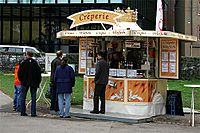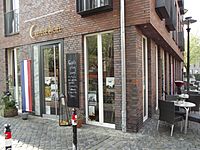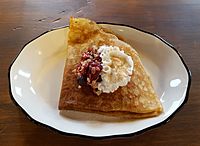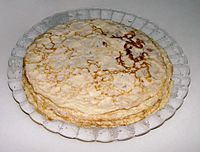Crêpe facts for kids
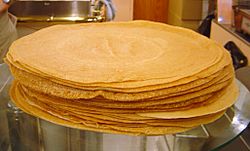
A stack of crêpes
|
|
| Alternative names | Crepe |
|---|---|
| Type | Pancake |
| Place of origin | France |
| Serving temperature | Warm, hot or cold |
| Main ingredients | Wheat flour or buckwheat flour, milk, eggs |

A crêpe is a super thin type of pancake that's popular all over the world! You might know them as either sweet crêpes or savory ones, called galettes. People often fill them with yummy things like cheese, jam, or chocolate spread. Sometimes, crêpes are even lit on fire for a cool show, like in the famous Crêpes Suzette.
Contents
What Does "Crêpe" Mean?
The word "crêpe" comes from an old French word. That word came from the Latin word crispa. Crispa means "curled" or "wrinkled." This makes sense because crêpes can look a bit wrinkled when they are cooked!
Crêpe Traditions and Fun Facts
Candlemas and Crêpes
In France, crêpes are a special treat for a Christian holiday called Candlemas. This day is on February 2nd. Long ago, around the year 472, a Roman Pope named Pope Gelasius I gave crêpes to French travelers visiting Rome. When they went back to France, they brought the crêpe tradition with them! That's why February 2nd is sometimes called "The Day of the Crêpes."
Crêpes and Good Luck
This day is also seen as a sign that winter is ending and spring is coming. The golden color and round shape of crêpes remind people of the sun. There are some fun traditions about making crêpes for good luck:
- If you hold a gold coin in your left hand and successfully flip a crêpe with your right hand, it's said to bring you wealth for the year!
- Some people even cook a crêpe with a gold coin on top for extra luck.
- Another tradition is to hide the first crêpe in a drawer instead of eating it. This is also for good luck in the coming year.
- Sharing crêpes with others on Candlemas is a tradition that comes from popes giving food to people in need.
There's a French saying that goes, "eating crêpes on Candlemas brings a year of happiness." Sounds like a good reason to eat crêpes!
Different Kinds of Crêpes
Crêpes come in two main types: sweet and savory.
Sweet Crêpes
Sweet crêpes are usually made with wheat flour. People enjoy them for breakfast or as a dessert. Some popular sweet fillings are:
- Hazelnut chocolate spread
- Jam or fruit spreads
- Sugar (plain or powdered)
- Maple syrup
- Lemon juice
- Whipped cream
- Custard
- Sliced soft fruits
Savory Crêpes
Savory crêpes are often made with different flours, like buckwheat. Buckwheat flour is naturally gluten-free. This is great for people who can't eat wheat or gluten. Savory crêpes are often eaten for lunch or dinner. Common savory fillings include:
- Cheese
- Ham
- Eggs
- Ratatouille (a vegetable stew)
- Mushrooms
- Various meats
Crêpe Cakes
You can also stack many thin crêpes on top of each other with cream in between to make a "crêpe cake." These cakes are usually sweet and can have fruits, chocolate, or cookies added. They often have 15-30 layers and are a fun alternative to a traditional birthday cake.
How Crêpes Are Made
The basic recipe for a French crêpe uses flour, eggs, milk, salt, and butter. Sometimes sugar is added for sweet crêpes. The ingredients are mixed to make a thin, runny batter. This batter is poured onto a hot, greased pan and spread out thinly. Crêpes cook very quickly, usually in about 20-30 seconds on each side!
In older recipes, people sometimes used beer or wine instead of milk. In some parts of France, especially Brittany, they often use buckwheat flour to make savory crêpes called Breton Galettes.
Crêperies: Places to Eat Crêpes
A crêperie is a place where you can buy and eat crêpes. It might be a small stall where you grab a crêpe to go, like street food. Or it could be a fancy restaurant or café where you sit down and enjoy your meal. Crêperies are common in France, especially in Brittany. Many crêperies also serve apple cider, which is a popular drink to have with crêpes.
Special Crêpe Creations
Mille Crêpes
Mille crêpes are a special kind of French cake made from many layers of crêpes. The word mille means "a thousand" in French, which hints at the many layers in the cake.
Crêpe Suzette
Another famous French crêpe is the crêpe Suzette. This crêpe has a light orange peel flavor and is often served with a special orange liqueur. The cool part is that the liqueur is usually lit on fire when it's brought to your table!
49er Flapjacks
The 49er flapjack is a type of sourdough crêpe popular in the United States. It got its name because this style of pancake was popular during the California Gold Rush in the 1800s. They are often rolled up with butter and powdered sugar, or served flat with maple syrup.
Crêpe dentelle is a super crispy cookie. It's made from a very thin crêpe that's folded into a cigar shape and then baked. People in France often enjoy it with a hot drink.
Crêpes Around Europe
Crêpes are loved in many European countries, but they have different names!
- In Norway, they're called pannekake.
- In most German areas, they're still called Crêpes.
- In Sweden, they're pannkaka or plättar.
- In Denmark, they're pandekager.
- In Iceland, it's pönnukaka.
- In Finland, they're ohukainen, lettu, or räiskäle.
- In Greece, it's krepa.
- In Dutch, it's a pannenkoek or flensje.
- In Afrikaans, it's a pannekoek, often served with cinnamon and sugar.
In parts of Spain, like Galicia and Asturias, crêpes are a traditional treat during carnivals. In Galicia, they're called filloas. In Asturias, they're fayueles or frixuelos. In Turkey, they're called akıtma.
Central and Eastern Europe
In countries that used to be part of the Austro-Hungarian empire, there's a thin pancake similar to a crêpe.
- In Austro-Bavarian, it's called Palatschinken.
- In Hungarian, it's palacsinta.
- In Bulgarian, Macedonian, Czech, Serbo-Croatian, and Slovenian, it's palačinka.
These are often eaten with fruit jam, cheese, sugar, honey, or chocolate spread. Some restaurants specialize in them and are called "Palačinkara."
Russian Blini
During the Russian celebration of Maslenitsa (also known as Russian Butter Week), a very popular food is blini, which are like crêpes. Since they are made with butter, eggs, and milk, they are allowed to be eaten during this time by the Orthodox church. Blini are served with butter and can be topped with caviar, cheese, meat, potatoes, mushrooms, honey, jam, or sour cream. Blini are round and golden, so they represent the sun and the start of spring!
-
Making Finnish crêpes called ohukainen
Crêpes Beyond Europe
Crêpes are also very popular in Japan and Malaysia. You can find sweet and savory crêpes sold at many small stands called crêperies.
Japanese Harajuku Crêpes
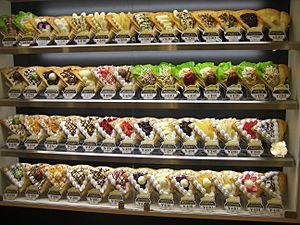
Japanese crêpes, often called 'Harajuku Crêpes', have become quite unique. When French crêpes first came to Japan in the 1970s, they were just spread with jam and weren't very popular. But in 1977, a shop in Harajuku started selling crêpes with ice cream, whipped cream, and sliced fruit. These became a huge hit! Japanese crêpes are often bought from street stalls and eaten while walking around.
Crêpes in the Americas
- In Argentina and Uruguay, crêpes are called panqueques. They are often eaten with dulce de leche, a sweet caramel-like spread.
- In Mexico, crêpes are known as crepas. They were brought to Mexico by the French in the 1800s. Mexican crepas can be sweet, filled with cajeta (similar to dulce de leche), or savory, filled with Huitlacoche (a type of corn mushroom that is a special food).
Similar Dishes Around the World
Many cultures have dishes similar to crêpes:
- In South India, a thin pancake made from fermented rice batter is called a dosa. It often has savory fillings.
- In Western India, a dish called "Pudlaa" or "Poodla" is made from gram flour with vegetables and spices.
- The injera of Ethiopian, Eritrean, Somali, and Yemeni cooking is often described as a thick crêpe.
- In the Philippines, daral is a native crêpe made from ground glutinous rice and coconut milk. It's rolled and filled with sweetened coconut meat.
- In Indonesia, Kue leker is a type of crêpe. Also, ledre is a rolled banana crêpe.
- In China, Jianbing is a traditional Chinese street food that looks like a crêpe. It's usually eaten for breakfast and includes an egg, crispy crackers, savory sauces, and chopped green onions.
See also
 In Spanish: Crep para niños
In Spanish: Crep para niños


